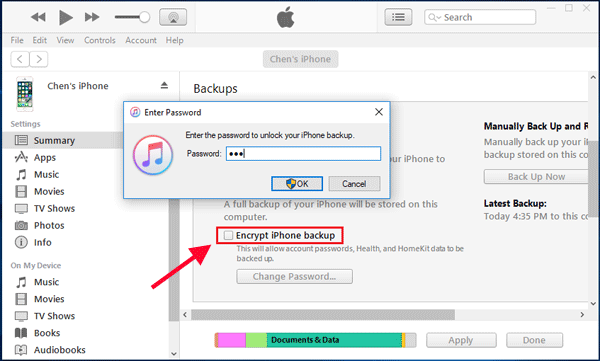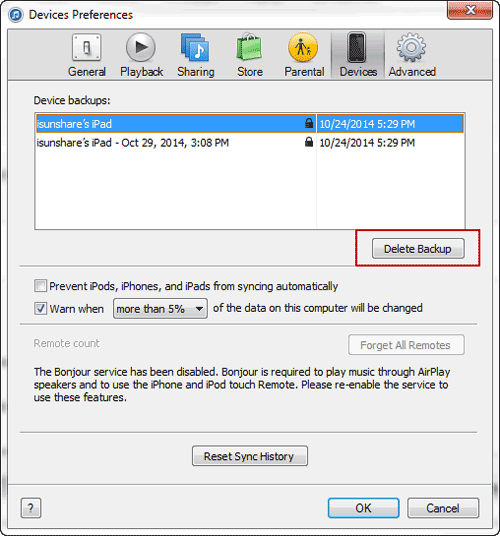

- #Itunes default backup folder how to
- #Itunes default backup folder install
- #Itunes default backup folder software
- #Itunes default backup folder Pc
- #Itunes default backup folder free
But in reality, you don't really have to know what it is, as you can symbolically link by following the steps below. You will probably find it not easy to understand what symbolic links are here.
#Itunes default backup folder Pc
Change iTunes backup location on Windows PC You can find the default iTunes location by the path we gave and rename the folder from “Backup” to “Old iTunes Backup” or others. Rename old iTunes backup folder on a system drive You can name the folder as "New iTunes Backup" or some other fairly descriptive names. Besides, you can create the folder on a flash drive, or USB stick, external hard drive, etc.
#Itunes default backup folder free
Create New iTunes Backup Folder on Another Driveįirst of all, you should create a new iTunes backup folder on drive D, drive E, or other drives with more free storage space.
#Itunes default backup folder how to
How to Change iTunes Backup Location on Windows PC # Step 1. How to Change iTunes Backup Location on Windows PC.Once linked, whenever iTunes tries to save a copy of the backup to C drive, the files are saved in the new backup folder. But then link the original backup file with the new backup folder. We will create a new save folder in another hard drive on the PC, such as drive D, drive E, etc.ITunes is configured to put all backups in the path shown above and we cannot choose to save these backup files directly to another drive. ITunes backup location in Windows 7/8/10: \ Users (username) \ AppData \ Roaming \ Apple Computer \ MobileSync \ Backup \.ITunes backup location in Windows XP: \ Documents and Settings (username) \ Application Data \ Apple Computer \ MobileSync \ Backup \.By default, iTunes will restore the backup files to the following path.Note: Before taking some action, you should read this guide on how to backup iTunes and what we are going to do. Here we will focus on how to change the default location of iTunes backup. In order to avoid this situation, you have two choices: either back up your iPhone / iPad to an external hard drive, or you need to change the iTunes backup location. Then we will probably get out of partition space in Windows systems. With the ever expanding iOS backup, the precious and often scarce C drive space will be constantly shrinking. ITunes keeps the iOS backup folder live on the drive system, usually on the C drive. Repair an iPhone that is stuck in iTunes with the USB cable (opens new window).Repair errors on iPhone and iTunes (opens new window).Can someone tell me how I can change the default iTunes backup location? "
#Itunes default backup folder install
Those are the update files downloaded to update your iOS devices."My C drive is full (there is only 2.5 GB free) and iTunes failed when backing up my iPhone 6 (32GB) while trying to install the new iOS 12 update, and at the same time OTA, a updated function, continues to fail. If you see it takes a lot of space, you are safe to delete them all.
#Itunes default backup folder software
Note the from the screenshot below?įurthermore, also check the iPhone Software Updates folder (%appdata%\Apple Computer\iTunes\iPhone Software Updates). You can also verify it with a dir from the command line. mklink /J "%appdata%\Apple Computer\MobileSync" "d:\data\itunes\mobilesync"ĭouble-check the folder list in Apple Computer folder, you will see a link icon appeared on the folder MobileSync indicating this is a symbolic link. Start a Command Prompt as Administrator, then run the following command to make the link. Make sure there is no MobileSync folder under Apple Computer after the data was moved.ģ. Move or create a folder that you want to store your backup files on your preferred location. Close iTunes, make sure it’s not running.Ģ. ITunes doesn’t offer an official way to change this setting but we can use the symbolic link to make a link between the folder iTunes expects to find and the folder that holds the real data. The better option is to relocate the Backup folder which by default is located at below. Then you may want to disable the Auto Sync on your iTunes so next time when you connect your device to your computer iTunes won’t back it up automatically. Go to the Devices tab, highlight the device and click Delete Backup. In your iTunes, click the icon at the top left corner and select Preferences. By deleting backup files on my iTunes, I immediately get 10GB of space back to my main C drive on SSD.

I could just delete the backup file for my iPhone and either don’t bother backing it up or just let iCloud to take care of this backup business for me.

When the total free space is shrinking to under 30GB as of now, I really hope I can get this 10GB back. It could be a big deal if you are running your Windows on a smaller SSD drive.įor example, my iTunes backup folder eats up over 10GB of space on my 128GB SSD drive. If you have iTunes installed on your computer to back up your iOS devices, you may want to check out how much spaces the backup files are taking.


 0 kommentar(er)
0 kommentar(er)
